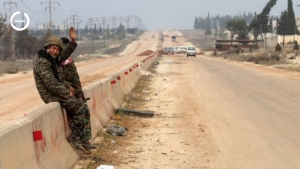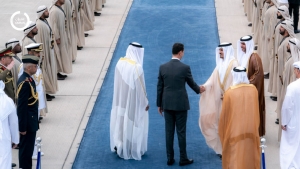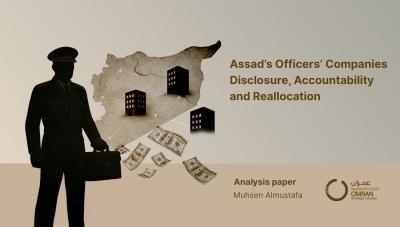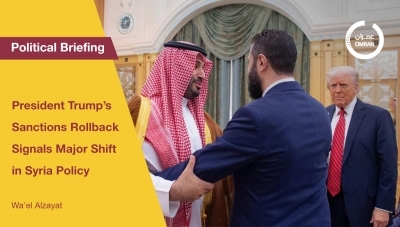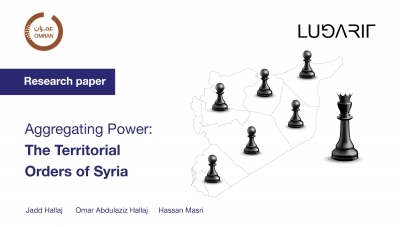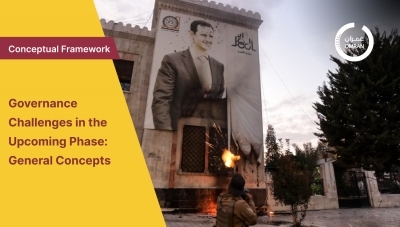Media Appearance
Monthly Briefing on the Events of the Syrian Scene March 2024
General Summary
This report provides an overview of the key events in Syria during the month of March 2024, focusing on political, security, and economic developments. It examines the developments at different levels.
- Politically, in its 13th year, the Syrian revolution is mired in political flux. Arab nations strive for reconciliation with Assad's regime, facing opposition from Western and the U.S. insistence on sanctions and normalization rejection. Amid these tensions, Assad's invitation by Bahrain to the Arab summit in May stands out. Concurrently, the push for the Syrian committee's ninth round of meetings by the international envoy is hampered by a location dispute between the regime and opposition.
- Security, the security environment in Syria, shadowed by the Gaza conflict, witnesses an upsurge in violence unprecedented since the halt of broader military operations. In Idlib, Russian airstrikes and regime artillery bombard rural and residential areas, escalating the use of suicide drones against civilians and military targets alike. Hay'at Tahrir al-Sham escalates its assault across Aleppo, Latakia, and Idlib. Meanwhile, the rise in ISIS activities in eastern Syria underscores the SDF's struggles against the group.
- Economically, despite a marginal uptick in the SYP's value, commodity prices soar, unaffected by the currency's stability. A landmark development is Iran's central bank's agreement to establish a joint Syrian-Iranian bank, marking a significant step towards deepening Iranian economic influence in Syria.
Decade Plus Three: Syrian Revolution and the Quest for Resolution
As the Syrian Revolution enters its 13th year, it continues to be marked by some Arab countries' attempts at rapprochement with the Assad regime, contrasted by Western countries' resistance to normalization and the ongoing lack of a viable political resolution. A united stance from the United States, Britain, France, and Germany has been articulated, showing firm opposition to normalizing relations with Assad's regime. They stress the importance of upholding sanctions and the need for a political settlement before beginning reconstruction efforts. Regionally, Bashar al-Assad's invitation to the upcoming Arab summit in Manama, Bahrain, on May 16, along with Faisal Mekdad (the regime's Foreign Minister) meeting his counterparts from Egypt, Lebanon, the United Arab Emirates, and Tunisia, indicates a shift towards nuanced Arab engagement.
Despite Assad's readmission into the Arab League at the 2023 Jeddah summit and the reestablishment of diplomatic relations with several Arab states, notably Saudi Arabia, there seems to be minimal readiness on his part to make meaningful concessions that would promote a political settlement or address security issues stemming from Syrian territory.
On the other hand, the Opposition's Syrian Negotiations Commission (SNC) has accepted an invitation from the UN special envoy to Syria, Geir Pedersen, to reengage in the Constitutional Committee's discussions. Despite agreeing to partake in the committee's 9th round next April, disputes over the meeting's venue persist, highlighting the deep-rooted divisions that complicate progress.
In Northwestern Syria, in Idlib, there has been an upsurge in public protests and civil demonstrations against Hay'at Tahrir al-Sham (HTS), with demands for improvements in security, administration, and services, as well as the release of detainees. These protests have been partly triggered by a series of arrests for alleged collusion within the ranks of HTS, including the death of a detainee due to torture. In an effort to address the unrest and bolster its internal legitimacy, the group has implemented several measures, including the declaration of a general amnesty and the introduction of structural reforms aimed at pacifying public dissent.
In Northeastern Syria, the Autonomous Administration of North and East Syria (AANES) has begun preparations for local elections, aiming to strengthen its legitimacy. The ratification of the High Electoral Commission law by the Syrian Democratic Council is a pivotal move toward affirming the administration's role as a legitimate authority over the region's population. However, the integrity of these elections hinges on the establishment of a system for independent and impartial monitoring and judiciary, an infrastructure the administration does not currently possess. Moreover, the decision of numerous political groups to boycott the elections, refusing to acknowledge the ANNES’s authority, suggests that the forthcoming elections may serve more as a symbolic gesture than a meaningful democratic process. This strategy seems to be an effort by the administration to divert attention from security and political dilemmas, alongside public calls for significant organizational reform. The pressing need for reform is underscored by increasing concerns over corruption, nepotism, and ideological control within its bodies, coupled with persistent appeals for the administration to distance itself from the PKK.
Gaza War Echoes: Rising Security Challenges and Internal Conflict
The ongoing conflict in Gaza is influencing Syria's security dynamics, with Israel launching strikes against Iranian forces and their allied militias. These strikes have included targets such as IRGC Military Advisor Riza Zirae in Baniyas, Tartus. The strikes have also hit several sites controlled by Hezbollah, including ammunition depots near Yabroud, Damascus, close to the Lebanese border. Moreover, Israeli operations have been concentrated in the south, particularly in Daraa and al-Quneitra, areas known for the activity of Iranian-backed militias. For a detailed overview of Israeli airstrikes in Syria since the beginning of 2024, please see Map (1).
![]()
Map (1): Map (1): Israeli Airstrikes Targeting Areas with Significant Iranian and Allied Presence & Influence – January 1, 2024, to April 1, 2024
Simultaneously, US airstrikes continue to target Iranian-backed militias in Deir Ezzor and the surrounding regions, resulting in injuries to individuals such as Haj Askar, a commander in the Iranian Revolutionary Guard. These persistent attacks highlight how Syrian territory is being used by regional and international powers to settle disputes and compete for influence. This dynamic is likely to further destabilize the already precarious security situation in Syria amid this power struggle.
Southern Syria is embroiled in a state of security turmoil and targeted violence, with Daraa particularly affected by the assassination of regime officers and security personnel via IED’s and shootings. The region has also experienced civilian deaths due to attacks by unidentified gunmen, underscoring the prevailing lawlessness. Efforts by local forces to target groups suspected of ISIS affiliations and individuals engaged in drug trafficking have been reported, including the notable killing of Shaker al-Shuwaier in Salkhad. The resurgence of drone technology for assassination purposes adds a layer of complexity to the already challenging security situation in southern Syria. These incidents of violence are part of a larger narrative involving ongoing reconciliations and the interaction between various local entities, such as regime forces, factions involved in settlements, and criminal organizations.
In Northwest Syria, Hay'at Tahrir al-Sham (HTS) has intensified its military actions against regime forces, resulting in both casualties and equipment losses. This increase in hostilities occurs alongside escalated Russian and regime airstrikes in the region, leading to a spike in violence. This includes the deployment of suicide drones by the regime, targeting both military and civilian objectives.
Eastern Syria has witnessed a surge in attacks by ISIS cells, challenging the Syrian Democratic Forces' (SDF) strategy to counteract them. In response, the SDF has executed targeted security operations to mitigate this threat. Notably, a recent operation by the Asayish forces against ISIS cells in al-Hasakah led to multiple arrests. Moreover, disturbances within SDF-administered prisons in al-Raqqa, including riots that resulted in casualties, signal underlying issues of discontent, and demands for improved treatment of detainees, particularly those linked to ISIS.
Inflation Outpaces Syrian Pound's Exchange Rate Improvement
In the Regime held-areas, the Syrian Pound (SYP) saw a modest increase in value against foreign currencies in March, driven by a combination of factors:
- A significant 50% rise in foreign remittances during Ramadan alleviated some of the pressure on the currency.
- A reduction in foreign trade activity led to a decreased demand for dollars.
- The demand for the SYP increased as individuals sold foreign currency to manage Ramadan expenses.
- The regime's government lowered the exchange rate for remittances by 100 liras, aiming to bridge the gap between the official and black-market rates and promote the use of formal channels for foreign currency inflows.
These factors collectively led to a temporary strengthening of the Syrian Pound. However, it's important to understand that this improvement is temporary and not due to monetary policy adjustments by the regime's Central Bank or improvements in production and foreign exchange reserves. The value of the lira is anticipated to fall after Ramadan.
Despite the lira's improved exchange rate, the cost of essential goods and materials continued to rise, with price increases exceeding 100% compared to the previous Ramadan. This indicates that the purchasing power of the population remains significantly compromised, largely due to the regime's policies, such as repeated increases in energy prices, prompting traders to guard against these hikes. Additionally, the regime continued to export vital crops and agricultural products, including staples like potatoes, garlic, and onions, despite domestic demand. The regime has decided to permit the export of various agricultural products, regardless of destination.
Iran is further expanding its influence within the Syrian economy, with the Central Bank of Iran authorizing the establishment of a joint Syrian-Iranian bank. This new bank is expected to facilitate financial transactions and enhance trade between the two countries. This move is in line with amendments to the Syria-Iran free trade agreement, which reduced customs duties on traded goods from 4% to 0%, likely increasing the presence of Iranian products in the Syrian market.
In the Opposition held-areas, the Salvation Government (SSG) in Idlib has eliminated certain fees for residential construction to ease recent protests against HTS. The SSG's Health Ministry also introduced regulations for the health sector, requiring licenses for pharmacies and medical supply stores.
In the countryside of Aleppo, basic commodity sales have plummeted by 50% due to skyrocketing prices and reduced purchasing power, in stark contrast to the previous Ramadan. Notably, meat and vegetable prices have surged, with meat prices increasing as regional traders buy up large quantities of sheep for smuggling. Additionally, investors have begun a project to build an earthquake-resistant residential city near al-Ra'i, which will include /1,500/ apartments.
In the SDF held-areas, the AANES has halted the export of sheep and cattle in response to a rise in local meat prices. Furthermore, fuel prices have skyrocketed by 170% without any formal announcement from AANES officials. Bread prices have also doubled, and vehicle registration fees have been adjusted to reflect the vehicle's year of manufacture, placing additional financial strains on residents, and diminishing their quality of life.
Monthly Briefing on the Events of the Syrian Scene November 2023
General Summary
This report provides an overview of the key events in Syria during the month of November 2023, focusing on political, security, and economic developments. It examines the developments at different levels.
- Politically, the political stance of Assad's regime towards the Israeli aggression on Gaza was aligned with Iran's approach of non-escalation and was consistent with the prevailing Arab official stance, attempting to use the event to increase interaction with the Arab and regional surroundings. However, the issuance of a French arrest warrant against Bashar al-Assad and other officials may negatively impact Assad's efforts to break his diplomatic isolation.
- Security, the ongoing war in Gaza cast its shadow over the security situation in Syria. Israel intensified its airstrikes against various military and logistical sites, notably the Damascus and Aleppo airports, which were put out of service again, while Iran-backed militias continue to expand their influence and move their forces to Syria's southern borders.
- Economically, inflation rates rose by over 800% in the last quarter of this year. The regime's government began exporting citrus crops from the coastal region to Iraq, marking a first-of-its-kind step between the two countries. The Chinese government also plans to provide support to the regime in telecommunications and solar energy.
Syrian Political Landscape: Assad's Diplomatic Maneuvers and Opposition Movements
Bashar al-Assad attended the Arab summit held in Saudi Arabia's capital. During his address, he denounced the Israeli aggression in Gaza, calling for an immediate halt to these acts and the facilitation of urgent aid to Gaza. Assad engaged in bilateral discussions at the summit with the leaders of Iraq, Egypt, Iran, and Mauritania seeking to mend ties with Arab and Islamic nations to alleviate his diplomatic seclusion and attempt to shift focus from his own human rights violations in Syria.
Simultaneously, Prime Minister “Hussein Arnous's” participation in the World Climate Summit in the UAE showcases the regime's keenness to engage in global forums, aiming to reintegrate into the international community and alleviate economic sanctions.
However, this diplomatic outreach coincides with a French arrest warrant issued against Bashar al-Assad, Maher al-Assad, and other Syrian officials, signifying a new chapter in the pursuit of justice for war crimes. This development poses a potential setback to Assad's diplomatic re-engagement efforts.
Domestically, Bashar al-Assad issued Legislative Decree No. 36 of 2023, offering a general amnesty for crimes committed before November 16, 2023. This move, not the first of its kind, seems to be an attempt to placate Arab and Western governments demanding such actions, and to reinforce the regime's stance on Arab initiatives for resolving the Syrian conflict. However, statistics show that less than 5% of opposition detainees have benefited from such amnesties, leaving over /135,000/ detainees still incarcerated since the revolution.
On the Syrian Opposition front, there has been a notable increase in meetings with envoys from various countries and international entities, with a focus on humanitarian issues and calls for enhanced European support, particularly in education. Key meetings include:
- The Syrian Negotiating Commission (SNC) Chairman met with the U.S. Deputy Assistant Secretary of State.
- The SNC delegation met with envoys from the USA, UK, France, Germany, the Netherlands, Switzerland, EU, Turkey, Italy, Denmark, Canada, Egypt, Qatar, and UN envoy Geir Pedersen in Geneva.
- The National Coalition of Syrian met with the Dutch Ministry of Foreign Affairs delegation in Istanbul.
Israeli Strikes in Syria: A Strategic Overview
Since the beginning of the Israeli aggression in Gaza, there have been about /23/ Israeli strikes targeting various locations in Syria, including /9/ strikes in November across the Damascus countryside, Daraa, and Homs. A notable strike was at Damascus International Airport, causing a temporary shutdown. Concurrently, Russia permitted Iranian flights from Tehran to land at the Khmeimim Air Base, as Damascus and Aleppo international airports were inaccessible. Additionally, these strikes hit air defense systems at Mezzeh military airport.The Israeli strikes were executed for several reasons:
- Retaliation against unidentified shelling from Daraa's countryside towards the occupied Golan Heights.
- Intent to impede the movement of Iranian officials into Syria.
- To deter the Syrian regime and Iran from escalating the conflict with Israel.
In Southern Syria, Iranian militias have expanded control near the occupied Golan border, transferring fighters from the Iraqi Popular Mobilization Units (PMU) and local militias from Deir Ezzor to the southern frontlines, meanwhile the regime's recent arrest campaign in southern Syria neutralized Russian-affiliated military personal, expanding by that the security gab in the southern region, while will allow Iran’s militia to expand and in increase its presence over there, posing a constant threat and serving as a leverage tool against the international community concerning Tehran's nuclear program and support for the Assad Regime.
In North-Eastern Syria, to secure the Syrian-Turkish border, prevent PKK infiltration, and combat drug and human trafficking, the Ministry of Defense of the Syrian Interim Government deployed 3,000 Syrian National Army members in border guard brigades. The National Liberation Front in Idlib province merged with smaller factions, reducing their number for more effective ground forces.
In Eastern Syria, “Tribal Forces” attacked Syrian Democratic Forces (SDF) positions in Deir Ezzor's eastern countryside. Turkish drones also conducted air raids in Hasakah province, resulting in casualties among the SDF.
Amid the global preoccupation with the war in Gaza, and in order to achieve field gains for the benefit of Assad's regime, Russian warplanes conducted several raids in different regions in Syria:
- /30/ raids in Idlib and Hama countryside targeting Hay'at Tahrir al-Sham and Ansar al-Tawhid, and supply lines in the al-Ghab Plain, claiming to target a drone depot in Idlib. HTS conducted /64/ operations against the regime, resulting in nearly /30/ fatalities among the Regime fighters.
- /60/ raids against ISIS hidden cells areas of presence in Hama desert, Homs, Deir Ezzor, and Raqqa, killing /13/ ISIS members. Meanwhile, in response to the 17’s ISIS cells recent attacks in Homs, Deir Ezzor, Raqqa, and Aleppo, causing /73/ fatalities, predominantly regime forces.
Syrian Economic Turmoil: Central Bank Struggles, Regional Partnerships, and Local Challenges
In the Regime Held-Areas, The Central Bank of Syria has been continuously floating the Syrian Pound's (SYP) value against foreign currencies, devaluing it by over 300% since the start of the year. The Syrian Pound’s recent valuation stands at /12,600/ SYO against the U.S. $, covering both cash exchange and foreign transfers. This strategy reflects the Central Bank's struggle against foreign exchange shortages, funding scarcities, and the challenge of combating the black market. This devaluation is a sign of the Central Bank's inability to stabilize prices, with inflation in Syria soaring to 800% in the last quarter of 2023. This dramatic inflation is attributed to the regime's diversion of resources to the military, production paralysis, scarcity of commodities, and international sanctions.
In a move to bypass sanctions and strengthen banking and trade relations, the Governor of the Central Bank of Iran, “Mohammad Reza Farzin”, visited Damascus. Both nations agreed to use local currencies in trade and establish communication channels between their central banks. Iran also plans to open its first bank in Syria soon.
Following Bashar al-Assad's visit to China, the Chinese government intends to support Syria in communications and solar energy, including expanding maritime digital transport equipment in Tartus and enhancing the international gateway.
Simultaneously, the Syrian regime is working to enhance economic relations with neighboring and allied countries. This includes updating a 1969 air transport services agreement with Iraq and initiating citrus fruit exports from Syria's Sahel region to Iraq, a first between the two countries.
In Latakia, the Farmers' Union warns of the potential extinction of cattle breeding due to soaring production costs, especially for fodder. Dairy and cheese prices have escalated, and the regime has increased fertilizer prices by about 200%, leading to higher food product prices. The meat market is also affected, with chicken prices in Homs governorate hitting /35,000/ SYP per kilo, leading to the closure of 75% of poultry farms due to financial losses.
As food and other product prices rise, the regime government has increased the cost of “unsubsidized” bread by over 100%.
In the SDF Held-Areas, transportation fares between northeastern Syrian cities and towns have been raised by 25% for the second time in two months.
Farmers in Deir Ezzor's eastern countryside face agricultural production challenges due to water scarcity and the Administration's failure to provide irrigation water and fuel distribution, threatening the effectiveness of land cultivation.
In the Opposition Held-Areas, the Ministry of Agriculture of the Syrian Interim Government launched a wheat crop support project in Aleppo's countryside, aiming to cultivate /2,000/ hectares with the support of the Trust Fund for the Reconstruction of Syria. The project encompasses several cities and towns, including al-Ghandoura, al-Rai, Bza'a, Marea and Azaz
Additionally, a 2-million-euro solar energy project for drinking water pumping stations was inaugurated in al-Bab city, funded by the Syria Recovery Trust Fund. This project, the largest of its kind in northern Syria, will serve 200,000 people with 2547 solar panels. Lastly, the “Sakan Foundation” continues its “Safe Haven” project in Kafr Taanour village, constructing /400/ residential houses for /2,396/ beneficiaries.

